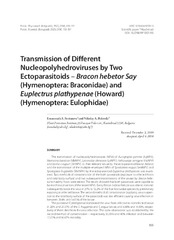| dc.description.abstract | The transmission of nucleopolyhedroviruses (NPVs) of Autographa gamma (AgNPV),
Mamestra brassicae (MbNPV), Lacanobia oleraceae (LoNPV), Helicoverpa armigera (HaNPV)
and Xantia c-nigrum (XnNPV) to their relevant larvae by the ectoparasitoid Bracon hebetor
and the transmission of the multiple-enveloped NPVs of Spodoptera exigua (SeMNPV) and
Spodoptera frugiperda (SfMNPV) by the ectoparasitoid Euplectrus plathypenae was examined.
Two methods of contamination of the both parasitoids (exposure to infected hosts
and total body surface) and two subsequent transmissions of the viruses by Bracon hebetor
to healthy hosts were tested. The results showed that both parasitoids were capable to
be mechanical vectors of the tested NPVs. Every Bracon hebetor female was able to transmit
subsequently twice the virus in 27% to 52.2% of the five Noctuidae species by preliminary
exposing to infected larvae. The second method of contamination (applying virus suspension
to the total body surface of the parasitoid) was also efficient causing virus infection in
between 29.4% and 54.15% of the larvae.
The parasitoid E. plathypenae transmited the virus from infected to noninfected larvae
in 20% and 25.57% of the S. frugiperda and S. exigua larvae, and 6.43% and 11.10%, respectively
of them died from the virus infection. The same observation was established by the
second method of contamination – respectively 33.33% and 40% infection and between
13.23% and 16.67% mortality.
The mortality of all tested larvae exposed to virus contaminated parasitoids was higher
when the parasitoid entire body surface had been artificially contaminated with the virus
than when the parasitoid itself was previously allowed to oviposit the larvae. | en |
| dc.description.abstract | Ispitivano je prenošenje virusa nuklearne poliedroze (NPV) poreklom iz Autographa gamma
(AgNPV), Mamestra brassicae (MbNPV), Lacanobia oleraceae (LoNPV), Helicoverpa armigera
(HaNPV) i Xantia c-nigrum (XnNPV) na njihove nezaražene larve pomoću ektoparazitoida
Bracon hebetor. Takođe je ispitivano prenošenja virusa nuklearne poliedroze sa višestrukom
membranom poreklom iz Spodoptera exigua (SeMNPV) i Spodoptera frugiperda
(SfMNPV) pomoću ekotoparazitoida Euplectrus plathypenae. Testirane su dve metode kontaminacije
oba parazitoida (izlaganje inficiranim domaćinima i ukupne površine tela). Takođe
su ispitivana dva uzastopna prenošenja virusa pomoću Bracon hebetor na zdrave domaćine.
Na osnovu dobijenih rezultata može se zaključiti da su oba parazitoida mehanički prenosioci
testiranih NPV. Svaka ženka Bracon hebetor je, ukoliko je prethodno bila izlagana inficiranim
larvama, bila u stanju da uzastopno dva puta prenese virus testiranih vrsta Noctuidae u iznosu
od 27% do 52,2%. Druga metoda kontaminacije (primena suspenzije virusa na celokupnu
površinu tela parazitoida) je takođe prouzrokovala virusnu infekciju larvi od 29,4 do 54,15%.
Parazitoid E. plathypenae je preneo 20% virusa sa inficiranih na larve S. frugiperda koje
nisu bile inficirane i 25,57% virusa na neinficirane larve i S. exigua.
Pored toga, ustanovljeno je da je 6,43% larvi S. frugiperda i 11,10% larvi S. exigua uginulo
kao posledica infekcije virusom. Ista pojava je zabeležena primenom druge metode
kontaminacije prilikom koje je ostvareno 33,33% i 40% infekcije, odnosno između 13,23% i
16,67% smrtnosti.
Smrtnost svih testiranih larvi izloženih virusom kontaminiranim parazitoidima bila je viša
kada je celokupna površina tela parazitoida bila veštački zaražena virusom u odnosu na
parazitoide kojima je prethodno dozvoljeno da polažu jaja u zaražene larve. | sr |



